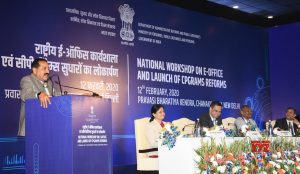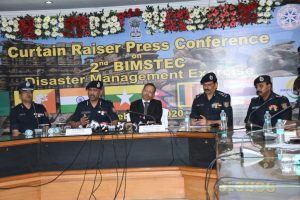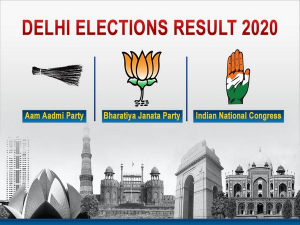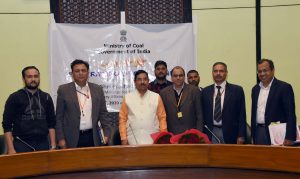 The Indian Railways South Central Railways (SCR) zone has become the 1st zonal railway in the country to have functional “energy neutral” railway stations on the network. The South Central Railways has converted a total of 13 railway stations into “energy neutral” stations, which is the highest amongst all the zones across the Indian Railways network. The energy-neutral railway stations are capable of meeting 100 per cent energy requirements by tapping into solar power through solar photovoltaic panels which have been commissioned at the station buildings. The Indian Railways South Central Railways (SCR) zone has become the 1st zonal railway in the country to have functional “energy neutral” railway stations on the network. The South Central Railways has converted a total of 13 railway stations into “energy neutral” stations, which is the highest amongst all the zones across the Indian Railways network. The energy-neutral railway stations are capable of meeting 100 per cent energy requirements by tapping into solar power through solar photovoltaic panels which have been commissioned at the station buildings. |
The 13 energy-neutral railway stations of the SCR zone are listed:
|
 Arvind Kejriwal takes oath as Chief Minister of Delhi for the third consecutive time in Ramlila Maidan. Mr. Kejriwal had earlier taken the oath of Chief Minister in 2013 and 2015 in the Ramlila Maidan. Ramlila Maidan served as the battleground for the 51-year-old bureaucrat turned-politician during India Against Corruption movement in 2011. Lieutenant Governor Anil Baijal administered the oath of office and secrecy to Mr. Kejriwal and his Cabinet colleagues. Six Member of the Legislative Assembly (MLAs) including Manish Sisodia and Gopal Rai were sworn in as cabinet ministers along with Aam Aadmi Party chief Arvind Kejriwal. Arvind Kejriwal’s new cabinet does not have any female representation. Arvind Kejriwal takes oath as Chief Minister of Delhi for the third consecutive time in Ramlila Maidan. Mr. Kejriwal had earlier taken the oath of Chief Minister in 2013 and 2015 in the Ramlila Maidan. Ramlila Maidan served as the battleground for the 51-year-old bureaucrat turned-politician during India Against Corruption movement in 2011. Lieutenant Governor Anil Baijal administered the oath of office and secrecy to Mr. Kejriwal and his Cabinet colleagues. Six Member of the Legislative Assembly (MLAs) including Manish Sisodia and Gopal Rai were sworn in as cabinet ministers along with Aam Aadmi Party chief Arvind Kejriwal. Arvind Kejriwal’s new cabinet does not have any female representation. |
The six cabinet ministers for Delhi is given below.
|
 National Workshop on e-office was inaugurated in New Delhi by Union Minister of State for Personnel, Public Grievances and Pensions, Dr Jitendra Singh. During the National Workshop on e-office, Centralized Public Grievance Redress And Monitoring System (CPGRAMS) Reforms also launched by the minister. After the launch, he stated that the number of public grievances has increased to 19 lakh at present from 2 lakh in 2014. The Government of India in 2019 has received 18.7 lakh public grievances and disposed 18.1 lakh of them. The Centralized Public Grievance Redress And Monitoring System (CPGRAMS) 7.0 version has mapped the last mile grievance officers hence saving the time as well as improving the quality of disposal of cases. The CPGRAMS aligns with the Government of India’s vision of “Minimum Government-Maximum Governance”. National Workshop on e-office was inaugurated in New Delhi by Union Minister of State for Personnel, Public Grievances and Pensions, Dr Jitendra Singh. During the National Workshop on e-office, Centralized Public Grievance Redress And Monitoring System (CPGRAMS) Reforms also launched by the minister. After the launch, he stated that the number of public grievances has increased to 19 lakh at present from 2 lakh in 2014. The Government of India in 2019 has received 18.7 lakh public grievances and disposed 18.1 lakh of them. The Centralized Public Grievance Redress And Monitoring System (CPGRAMS) 7.0 version has mapped the last mile grievance officers hence saving the time as well as improving the quality of disposal of cases. The CPGRAMS aligns with the Government of India’s vision of “Minimum Government-Maximum Governance”. |
 BIMSTEC Disaster Management Exercise 2020 has been started in Bhubaneswar, Odisha. The National Disaster Response Force (NDRF) is organizing the BIMSTEC Disaster Management Exercise 2020 on behalf of the Government of India. The BIMSTEC Disaster Management Exercise was inaugurated by Odisha Chief Minister Naveen Patnaik. BIMSTEC Disaster Management Exercise 2020 has been started in Bhubaneswar, Odisha. The National Disaster Response Force (NDRF) is organizing the BIMSTEC Disaster Management Exercise 2020 on behalf of the Government of India. The BIMSTEC Disaster Management Exercise was inaugurated by Odisha Chief Minister Naveen Patnaik. |
|
|
 The Vivad se Vishwas Scheme was announced by Finance Minister Nirmala Sitaraman during the Budget 2020-21. On February 12, 2020, the Union Cabinet approved to make required changes in the Vivad Se Vishwas Bill, 2020 in order to widen its cover over litigation pending in debt recovery tribunal. The Vivad se Vishwas Scheme was announced by Finance Minister Nirmala Sitaraman during the Budget 2020-21. On February 12, 2020, the Union Cabinet approved to make required changes in the Vivad Se Vishwas Bill, 2020 in order to widen its cover over litigation pending in debt recovery tribunal. |
|
|
|
 On February 13, 2020, the Ministry of MSME (Micro, Small and Medium Enterprises) launched “Apiary on Wheels”. It is a unique concept framed by KVIC (Khadi and Village Industries Commission). The main aim of “Apiary on Wheels” is to make migration easy. On February 13, 2020, the Ministry of MSME (Micro, Small and Medium Enterprises) launched “Apiary on Wheels”. It is a unique concept framed by KVIC (Khadi and Village Industries Commission). The main aim of “Apiary on Wheels” is to make migration easy. |
|
|
|
 The Government of India has decided to consider all medical devices including implants and contraceptives as “Drugs”. The notification regarding the re-categorization was issued by the Ministry of Health and Family Welfare. With the implementation, all the medical devices will come under the purview of the Central Drugs and Standard Control Organization (CDSCO). The re-categorization will be implemented from 1st April 2020 in the phase manner. The re-categorization will enable the drugs regulator “CDSCO” to tighten the regulation to improve the safety and quality. The medical devices that will be re-categorized as per the notification issued by the Ministry of Health and Family Welfare, includes the devices that are used for life support, diagnosis, treatment or alleviation of any disease or disability. It also includes the devices that are used to disinfect other medical devices. This notification will effectively cover all medical devices that are sold in the market. Ministry of Health and Family Welfare will also release another notification stating a transition period for various categories of medical devices. The Government of India has decided to consider all medical devices including implants and contraceptives as “Drugs”. The notification regarding the re-categorization was issued by the Ministry of Health and Family Welfare. With the implementation, all the medical devices will come under the purview of the Central Drugs and Standard Control Organization (CDSCO). The re-categorization will be implemented from 1st April 2020 in the phase manner. The re-categorization will enable the drugs regulator “CDSCO” to tighten the regulation to improve the safety and quality. The medical devices that will be re-categorized as per the notification issued by the Ministry of Health and Family Welfare, includes the devices that are used for life support, diagnosis, treatment or alleviation of any disease or disability. It also includes the devices that are used to disinfect other medical devices. This notification will effectively cover all medical devices that are sold in the market. Ministry of Health and Family Welfare will also release another notification stating a transition period for various categories of medical devices. |
| Present rules for the classification of medical devices in India: |
In India, the medical devices are classified under four categories:
|
| Examples of medical devices as per their category: |
|
| According to the present medical rules, CDSCO issues licenses to the private notified bodies for the inspection of low risk-devices. But, in case of high risk devices, CDSCO is responsible for the issuing of licenses as well as for the inspection of the high risk devices. |
 In Delhi Assembly Election, Arvind Kejriwal’s Aam Aadmi Party scored a landslide victory. This is the second time in a row as Aam Aadmi Party swept aside both BJP, which was again restricted to a single digit and Congress which could not win a single seat. In the 2015 Assembly Election, the Aam Aadmi Party (AAP) had won 67 seats out of 70. BJP has won eight seats, five more than the 2015 assembly election. However, the party managed to increase its vote share by over 6% from the last elections. 0.5% (approx) voters pressed the NOTA (None of the Above) button. Aam Aadmi Party’s Sanjeev Jha records the biggest victory margin of over 88,000 votes from Burari Assembly/Vidhan Sabha seat. Delhi CM Arvind Kejriwal won the elections from New Delhi while Deputy Chief Minister Manish Sisodia from Patparganj Assembly/Vidhan Sabha seat. Mr. Kejriwal thank the people of Delhi for reposing their faith in Aam Aadmi Party for the third time. Delhi Chief Minister Arvind Kejriwal said that “This is the victory of the people who consider me as their son and voted for us”. He said, “This is the beginning of a new kind of politics”. In Delhi Assembly Election, Arvind Kejriwal’s Aam Aadmi Party scored a landslide victory. This is the second time in a row as Aam Aadmi Party swept aside both BJP, which was again restricted to a single digit and Congress which could not win a single seat. In the 2015 Assembly Election, the Aam Aadmi Party (AAP) had won 67 seats out of 70. BJP has won eight seats, five more than the 2015 assembly election. However, the party managed to increase its vote share by over 6% from the last elections. 0.5% (approx) voters pressed the NOTA (None of the Above) button. Aam Aadmi Party’s Sanjeev Jha records the biggest victory margin of over 88,000 votes from Burari Assembly/Vidhan Sabha seat. Delhi CM Arvind Kejriwal won the elections from New Delhi while Deputy Chief Minister Manish Sisodia from Patparganj Assembly/Vidhan Sabha seat. Mr. Kejriwal thank the people of Delhi for reposing their faith in Aam Aadmi Party for the third time. Delhi Chief Minister Arvind Kejriwal said that “This is the victory of the people who consider me as their son and voted for us”. He said, “This is the beginning of a new kind of politics”. |
|
Party wise Vote Share in Delhi Assembly Results in 2020 (in %)
|
 Ministry of Coal (MoC) has launched a web portal for star rating of coal mines to promote the green, safe and sustainable mining practices with the help of technology. The web portal for star rating of coal mines enables all operational coal mines across India for self-rating, their subsequent validation by Coal Controller’s Organization (CCO), further evaluation and finally award of star rating. The mines scoring the highest score in the country will be awarded in a public ceremony on the basis of the star ratings obtained on this web portal. Coal Controller’s Organization will also issue an official certificate to all the mines mentioning their star rating. The Star Rating Policy for Coal Mines in India are: Ministry of Coal (MoC) has launched a web portal for star rating of coal mines to promote the green, safe and sustainable mining practices with the help of technology. The web portal for star rating of coal mines enables all operational coal mines across India for self-rating, their subsequent validation by Coal Controller’s Organization (CCO), further evaluation and finally award of star rating. The mines scoring the highest score in the country will be awarded in a public ceremony on the basis of the star ratings obtained on this web portal. Coal Controller’s Organization will also issue an official certificate to all the mines mentioning their star rating. The Star Rating Policy for Coal Mines in India are: |
 Atal Innovation Mission, NITI Aayog has begin a series of innovation demo days. The series aims to unite the stakeholders of the food processing and agriculture sector in India. The innovation demo days will act as a platform where start-ups, Micro, Small and Medium Enterprises (MSMEs), entrepreneurs, corporate partners and sector academics are brought together to be spectator of government-funded innovations. Atal Innovation Mission, NITI Aayog has begin a series of innovation demo days. The series aims to unite the stakeholders of the food processing and agriculture sector in India. The innovation demo days will act as a platform where start-ups, Micro, Small and Medium Enterprises (MSMEs), entrepreneurs, corporate partners and sector academics are brought together to be spectator of government-funded innovations. |
|
|
You need to login to perform this action.
You will be redirected in
3 sec
